
- •Voronezh state university
- •50 Things you need to know about britain.
- •50 Things you need to know about britain.
- •1). Stonehenge
- •2). St. Augustine and Christianity
- •3). Canterbury Tales
- •4) Religious settlement
- •5) Shakespeare
- •6) Gin craze and British drink culture
- •Battle of Waterloo and national identity
- •* The battlefield today
- •8)The Red House and ‘my house is my castle’
- •10) The Beatles
- •Alfred the Great.
- •Magna Charta (1215).
- •3) English Civil war of 1642 -1649.
- •4) The Glorious Revolution. (1688 - 89)
- •5) Birth of Great Britain, Act of Union in 1707.
- •6) Robert Walpole – the first Prime Minister.
- •The British Bobby.
- •Suffragettes
- •*The Suffragettes wanted the right for women to vote.
- •9). National Health Service
- •Results
- •(Http://en.Wikipedia.Org/wiki/Welfare_state_in_the_United_Kingdom) *The National Health Service
- •10). Britain Joining Europe*
- •*A History of the European Union and Great Britain
- •Introduction.
- •1). The Roman Invasion
- •2). The Norman invasion of 1066
- •3). Elizabeth I and the Spanish Armada
- •4). East India Company and the battle of Plassey
- •5) Tea and American Revolution
- •1. What is understood by the “Boston Tea Party”*?
- •3. Why did the British loose the battle?
- •6) Nelson and the Battle of Trafalgar
- •7). Slave trade
- •Campaign to abolish the slave trade
- •8) Dr Livingston and exploration of Africa*
- •9)The Windrush and the Empire
- •Identity
- •10). The Channel Tunnel* and the Eurostar
- •Early Plans
- •A Contest
- •The Design for the Channel Tunnels
- •Getting Started
- •Building the Channel Tunnel
- •Connecting the Tunnels
- •Finishing the Channel Tunnel
2). St. Augustine and Christianity
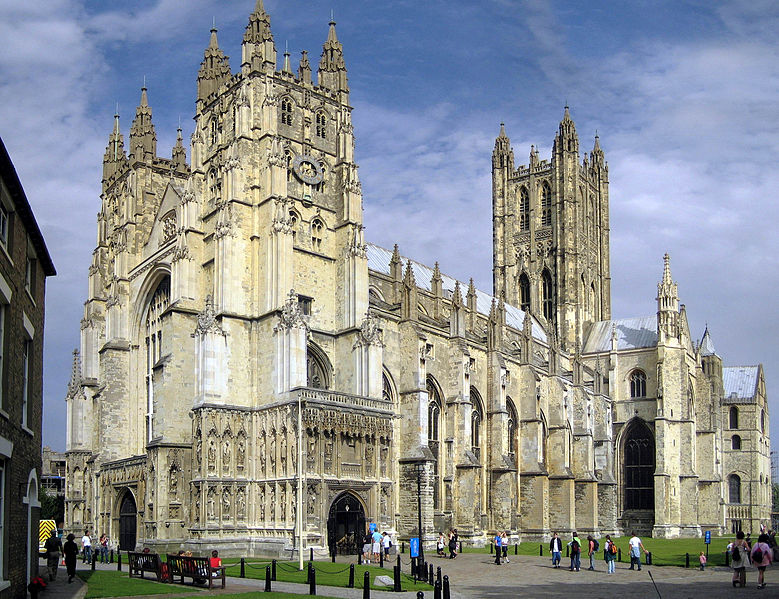
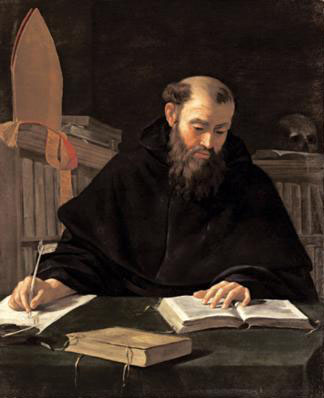
Canterbury Cathedral Augustine of Canterbury by Caravaggio
Task 3. Pick out the sentences where the following phrasal verbs are used:
Be about to change – идти к перемене (2)
Fall out – поссориться (2)
Task 4. Fill in the gaps while viewing.
Britain today on paper is a 1)……… country. Christianity has played a great part in making British identity. One man did more than any other to bring Christianity to the British shores. Celts and Anglo-Saxons 2)… ……… (поклонялись) pagan (языческим) Gods* for centuries. All this was about to change in 597 because 3)…. ……. decided to bring the Christian Gospel to 4)….. England. He wanted the pagan English and their king Aethelberht to become Christian. The Venerable Bede* wrote that a Benedictine monk (монах) Augustine* was selected to go to Britain to convert the pagan king Aethelberht. 5)………. must have been impressive because King Aethelberht allowed him 6).. …… (проповедовать) the Gospel of Christ to his men. Augustine also baptized (крестил) the king before the year 597 was out. He also 7) …….. thousands of his men in what is known as the baptismal miracle at Canterbury.
But Anglo-Saxon pagan gods were still popular, so Augustine carefully incorporated pagan feasts into the Christian 8)…….. . Mid-winter solstice ( солнцестояние) became associated with the birth of Jesus Christ and was called 9)……… . Oistra, an Anglo-Saxon ( Celtic Eostra) goddess, who symbolized spring, represented rebirth, new life and 10)…..’s fertility (плодовитость) gave name to 11)…… festival. Over the coming centuries Christianity became more and more widespread. Christian faith (вера) and a local parish church (приходская церковь) became a major root of Britishness. Christianity was here to stay, and Christian rituals have marked the key moments in human life - birth, marriage and death - ever since. Today 71 per cent of British still claim to be Christian. Augustine built Canterbury Cathedral* and became the first archbishop of Canterbury.
The most famous Archbishop of Canterbury became Thomas Becket . He had a major falling out with King Henry II and was brutally murdered in the Cathedral. He became the most famous martyr in England. Pilgrims began to come to his tomb.
Cultural Commentary
*Pagan
Gods and goddesses - Aine
of Knockaine
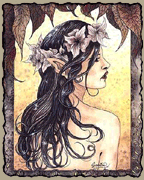
Celtic (Irish) Goddess of love and fertility, later known as the fairy queen. Goddess related to the moon, crops, and farms or cattle. Aine is revered among Irish herbalists and healers and is said to be responsible for the body's life force. A woman of the Leanan Sidhe (Sweetheart of the Sidhe). Some said she was the daughter of Manannan, some said she was the Morrigan herself. There was a stone, Cathair Aine, belonging to her and if anyone sat on the stone, they would be in danger of losing their wits, sit three times and they would lose them forever. Aine was very revengeful, and it was not a safe thing to offend her.
Camalus
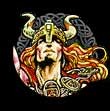 "Of
the Invisible Sword", "Heaven". Celtic God of war and
sky. Similar to Mars, only more vicious.
"Of
the Invisible Sword", "Heaven". Celtic God of war and
sky. Similar to Mars, only more vicious.
Cernunnos
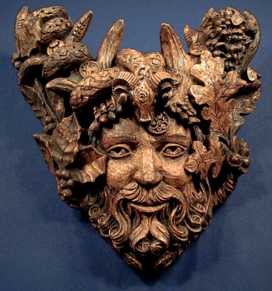 Celtic
God of virility, fertility, life, animals, forests and the
underworld. The Horned or Antlered God is born at the winter
solstice, marries the Goddess at Beltane, and dies at the summer
solstice. He alternates with the Goddess of the moon in ruling over
life and death, continuing the cycle of death, rebirth and
reincarnation.
Celtic
God of virility, fertility, life, animals, forests and the
underworld. The Horned or Antlered God is born at the winter
solstice, marries the Goddess at Beltane, and dies at the summer
solstice. He alternates with the Goddess of the moon in ruling over
life and death, continuing the cycle of death, rebirth and
reincarnation.
Symbolizes element of earth, love, fertility, death the virile male aspect and the dark half of the year. The two fold aspect of the God year with the Greenman or Jack o' the Green being his light aspect. This takes on a similarity to the Oak King and Holly King legend. Leads the wild hunt at Samhain, hence the day best associated with the Dark Lord. Also A consort to the mother Goddess. Druids knew him as Hu Gadarn, the Honored God. Ancient Celtic images show him seated in a lotus position, naked, with antlers or horns on his head. Christians demonized this benevolent God for easy conversion and is where the image of the Christian devil comes from(Couldn't be further from facts nor truth but alas yet another tragedy of misdeed and "bearing false witness", to quote a commandment).
Animals that were sacred to him: bull, ran, stag, and horned serpents. Variants: Cerowain, Cernenus, Herne the Hunter.
Don
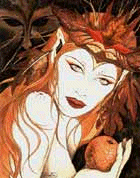 Celtic
(Welsh) Queen of the Heavens and Goddess of air and sea. Ruled over
the land of the dead. Corresponds to
the
Celtic (Irish) Goddess Danu. Symbolizes control of the elements, the
moon.
Celtic
(Welsh) Queen of the Heavens and Goddess of air and sea. Ruled over
the land of the dead. Corresponds to
the
Celtic (Irish) Goddess Danu. Symbolizes control of the elements, the
moon.
Epona
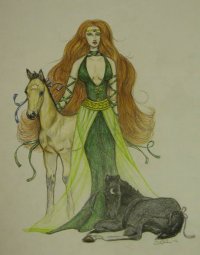
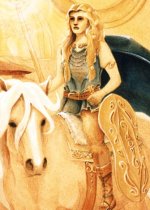
Celtic (Britania & Gaul) Goddess of horsebreeding, healing spring, prosperity and mountains. Called Divine Horse and the Great Mare, the Goddess of horses was acknowledged and worshipped by Roman soldiers. Her symbols were horses and dogs.
Eostre
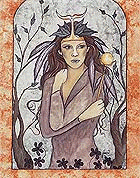 Celtic
(Irish & Britania) Goddess of Spring, worshipped at festivals all
over Britain. She gave her name to Easter and some of the present
folk customs performed at that time may be traced to those who
worshipped her.
( www.angelfire.com/wizard/celticdeities/)
Celtic
(Irish & Britania) Goddess of Spring, worshipped at festivals all
over Britain. She gave her name to Easter and some of the present
folk customs performed at that time may be traced to those who
worshipped her.
( www.angelfire.com/wizard/celticdeities/)
*Venerable Bede – was an English monk at the Northumbrian monastery of Saint Peter
at Monkwearmouth and of its companion monastery, Saint Paul's, in modern Jarrow , both in the Kingdom of Northumbria. He is well known as an author and scholar, and his most famous work, Historia ecclesiastica gentis Anglorum (The Ecclesiastical History of the English People) gained him the title "The Father of English History".
In 1899, Bede was made a Doctor of the Church byLeo XIII, a position of theological significance; he is the only native of Great Britain to achieve this designation (Anselm of Canterbury, also a Doctor of the Church, was originally from Italy). Bede was moreover a skilled linguist and translator, and his work with the Latin and Greek writings of the earlyChurch Fathers contributed significantly to English Christianity, making the writings much more accessible to his fellow Anglo-Saxons. en.wikipedia.org/wiki/
*Augustine of Canterbury was a Benedictine monk who became the first Archbishop of Canterbury in the year 597. He is considered the "Apostle to the English" and a founder of the English Church. Augustine was the prior of a monastery in Rome when Pope Gregory the Great chose him in 595 to lead a mission, usually known as the Gregorian mission, to Britain to Christianize King Æthelberht and his Kingdom of Kent from their native Anglo-Saxon paganism. Kent was probably chosen because Æthelberht had married a Christian princess, Bertha,who was expected to exert some influence over her husband. Before reaching Kent the missionaries had considered turning back but Gregory urged them on, and in 597 Augustine landed
on the Isle of Thanet and proceeded to Æthelberht's main town of Canterbury. King Æthelberht converted to Christianity and allowed the missionaries to preach freely, giving them land to found a monastery outside the city walls. Augustine was consecrated as a bishop and converted many of the king's subjects, including thousands during a mass baptism on Christmas Day in 597. en.wikipedia.org/wiki/
*Canterbury Cathedral - Canterbury Cathedral in Canterbury, Kent, is one of the oldest and most famous Christian structures in England and forms part of a World Heritage Site. It is the cathedral of the Archbishop of Canterbury, leader of the Church of England and symbolic leader of the worldwide Anglican Communion. Its formal title is the Cathedral and Metropolitical Church of Christ at Canterbury. Founded in 597, the cathedral was completely rebuilt from 1070 to 1077. The east end was greatly enlarged at the beginning of the twelfth century, and largely rebuilt in the Gothic style following a fire in 1174, with significant eastward extensions to accommodate the flow of pilgrims visiting the shrine of Thomas Becket, the archbishop who was murdered in the cathedral in 1170. The Norman nave and transepts survived until the late fourteenth century, when they were demolished to make way for the present structures. en.wikipedia.org/wiki/Canterbury_Cathedral
